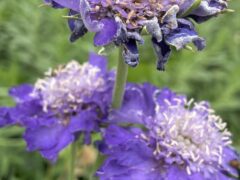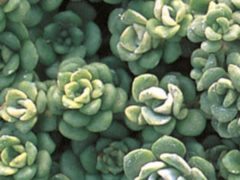winter savory
Satureja montana
With its strong spicy flavor, winter savory goes well with beans and meats, and including … Continued
Drought-tolerant and drought-resistant plants may still need supplemental water from time to time, but they can survive periods of dryness without dying.
Drought-resistant plants like cactus, hens and chicks, and sedums can go for very long periods without water and do not tolerate poorly drained locations. Drought-resistant tropical plants grown indoors in winter like cactus, Sansevieria, Echeveria, and other succulents sometimes fail due to overwatering.
Drought-tolerant plants grow in many textures and sizes and have different adaptations that help them get through periods of drought:
The latter two types of plants are drought tolerant once established because any new planting, regardless of drought tolerance, needs to be watered during the first growing season to allow roots to reach the depths needed to access moisture during dry periods.
It’s also important to note that survival may not mean that the plant will look its best during this time. Watering weekly for a longer period of time will result in the best-looking gardens with the highest tolerance for drought. During the hottest, dryest times in summer, watering deeply twice a week is recommended. These less frequent waterings will encourage root systems to expand, making it easier for plants to access moisture when their environment is dry.
Winter drought has become a bigger problem in recent years as snowfall declines. Evergreen plants are especially vulnerable during winter drought because their foliage continues to shed moisture while dormant deciduous plants have shed their leaves and can conserve moisture in woody stems and underground. Watering shrubs and trees in winter on days when the temperature allows (above freezing) will help ensure their healthy return in spring.
Here are some drought-tolerant and drought-resistant plants to grow—
Satureja montana
With its strong spicy flavor, winter savory goes well with beans and meats, and including … Continued

Scabiosa columbaria ‘Butterfly Blue’
Perennial Plant Association 2000 Perennial Plant of the Year! A compact, long-blooming perennialproduces flowers from … Continued

Scaevola aemula ‘Bombay Dark Blue’
Fan-shaped flowers that give the genus its common name produce vivid purple-blue petals all summer … Continued

Scaevola aemula ‘Scalora Glitzy’
Fan-shaped flowers that give the genus its common name produce vivid purple-blue petals all summer … Continued

Salvia coccinea
This showy southern native grows loose, widely blooms on spikes from spring through fall. Grow it … Continued

Schizachyrium scoparium
Perennial Plant Association 2022 Perennial Plant of the Year! State grass of Kansas Silvery-blue foliage … Continued

Scutellaria resinosa ‘Smoky Hills’
‘Smoky Hills’ is an improved selection of prairie skullcap originally collected in the Smoky Hills … Continued

Sedum 'Herbstfreude'
Large salmon-pink flower heads tinged with bronze and open late summer through fall. Plants grow … Continued

Sedum 'Back in Black'
An upright sedum with near-black leaves! When late summer rolls around, flowers with deep garnet … Continued

Sedum reflexum 'Angelina'
Thin, evergreen, spiny golden-yellow foliage radiates around central stem and is tinged russet orange at … Continued

Sedum spathulifolium ‘Harvest Moon’
Silver-white leaves; yellow flowers in summer on this choice rock garden or trough plant. Choice … Continued

Sedum kamtschaticum var. middendorffianum ‘Variegated’
Narrow green toothed leaves on plants growing just 8-12″ tall and topped with yellow flowers … Continued